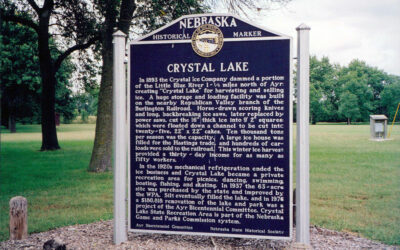“The romance about the contemplated removal of the state penitentiary from Lincoln to Kearney is becoming interesting,” said the Kearney Hub on May 16, 1892. “At first it had the appearance of a joke. Now the newspapers have progressed so far as to be able to give the details of the whole scheme. The Ravenna News devotes a third of a column to the subject, from which it is learned that a syndicate of capitalists has been formed to offer a large tract of land, a big cash bonus, etc., etc.”
The article in the Ravenna News referred to by the Hub, had appeared on May 12, updating readers in Buffalo County on the ongoing effort by a group of Kearney residents to persuade the state of Nebraska to relocate its penitentiary to their city. The News said: “It will be remembered that about six weeks ago during the severe wind storm which swept over the state, a big section of the penitentiary wall fell down. The breach was at once repaired, but it is said that the workmen made the discovery that the wall, instead of being solid, was filled in the center with sand, and was liable to fall at any time. An attempt was made to hush the matter up, but it has leaked out.”
 Governor Charles H. Dietrich, who at first favored, but later opposed, relocation of the Nebraska State Penitentiary in 1901. NSHS RG2411-1338-b
Governor Charles H. Dietrich, who at first favored, but later opposed, relocation of the Nebraska State Penitentiary in 1901. NSHS RG2411-1338-b
Believing that the entire wall would have to come down within a year or so, Kearney businessmen tried to persuade the state to rebuild the penitentiary in their city, offering “a large tract of land and a liberal bonus” as an inducement for the removal. The Kearney boosters thought that Lincoln “should be relegated to the rear in this matter and that the western part of the state should be given a chance.”
Apparently the inducements offered by the Kearney capitalists in 1892 were not sufficient to effect the relocation of the state penitentiary. A fire at the institution in March of 1901 prompted further discussion about its possible removal from Lincoln. The Omaha Bee on March 11 reprinted press comments from around the state, including Governor Charles H. Dietrich’s proposal to rebuild “where there can be plenty of good farming land to go with it and that the time of the convicts be employed in raising sugar beets.” However, nothing came of it, with the Kearney Hub commenting on March 19 that Dietrich “doubtless finds that to rebuild entire elsewhere would cost more than the state can afford to expend on the institution.” – Patricia C. Gaster, Assistant Editor / Publications




